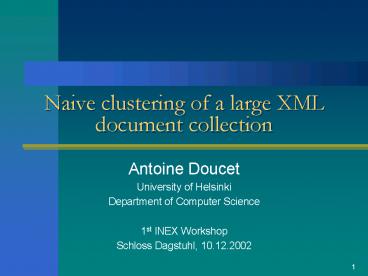Naive clustering of a large XML document collection PowerPoint PPT Presentation
1 / 25
Title: Naive clustering of a large XML document collection
1
Naive clustering of a large XML document
collection
- Antoine Doucet
- University of Helsinki
- Department of Computer Science
- 1st INEX Workshop
- Schloss Dagstuhl, 10.12.2002
2
Introduction
- Conjecture
- As structure is supplementary information
to raw text, there must exist a way to exploit
it, that improves the clustering quality - Document Clustering
- in IR
- XML Document Clustering
3
Introduction
- Clustering experiments
- Various feature sets
- k-means clustering
- Clustering quality evaluation
- Results and future work
4
Document Clustering
5
Document Clustering in IR
- Prior to the query
- Goal form a taxonomy (Yahoo!)
- Post-Retrieval Clustering
- Cluster Hypothesis
6
XML Document Clustering
- Most work on data-centric XML, that is
- regular structure
- few/poor text content
- Edit Tree Distance
- as a preprocessing of automated DTD
- construction methods
7
Clustering Experiments
8
Vector Space Model
- Various feature sets
- tags only (183)
- text only (188,417)
- text and tags (188,600)
- normalized tf-idf
9
Clustering
- Similarity measure cosine
- k-means algorithm
10
k-means clustering algorithm
- Initialisation
- k points chosen as centroids
- Assign each point to the closest centroid
- Iterate
- Re-compute the centroid of each cluster
- Assign each point to the closest centroid
- Stop Condition
- As soon as the centroids are stable
11
Clustering
- Similarity measure cosine
- k-means algorithm
- partitional
- linear
12
Clustering Evaluation
- Internal Quality Measures
- based on average inter- and intra-cluster
similarities - for example
- cohesiveness (a.k.a. overall similarity)
- Inappropriate for our experiments
- Because we use different feature sets, and the
similarity measures are intrinsecally related to
the document representation, the similarity
measures are not comparable over different
feature sets (that is, throughout our
experiments).
13
Clustering Evaluation
- External Quality Measures
- Based on an existing manual classification
- Entropy is based on the classes distribution in
a cluster. - Purity measures how much a cluster is
specialized in a class. - F-measure originates from IR.
14
Clustering Evaluation
- External Quality Measures
- Which classification can we use ?
- Usually (TREC) manual assessments are used as
classes - INEX assessments were not yet available
- The only available classes are the journals in
which the articles were published
15
Clustering Evaluation
- Problems with the journal title classification
- The classes are disjoint.
- Obviously does not suit text documents
- The classes are probably too strict.
- e.g.,there should not be a strict border between
Transactions on Computers and Transactions on
ParallelDistributed Systems - ...Finally we used the 18 journal classes an
extra volume class
16
Results
17
Results
- 15-way clustering
Features Text Tags Text Tags
Entropy 0.633 0.798 0.678
Purity 0.379 0.228 0.372
Time 754 s. 11 s. 837 s.
- Text is best !
- Tags only is very fast
18
Results
- The volume class exception
Features Text Tags Text Tags
Entropy 0.722 0.016 1
Purity 0.295 0.992 0
Precision 28 99 100
Time 754 s. 11 s. 837 s.
- The most discriminant text features are
misleading january, society, publish - The most discriminant tag features are not
ltentitygt, lttitlegt, ltsec1gt
19
Results
- Hints at a better method, by using the tag
features as a preprocessing - k-means clustering based on tags only
- The n clusters with a cohesiveness above a given
threshold are kept - (k-n)-means clustering of the remaining documents
based on text features only
20
Results
- 15-way clustering with and without pre-clustering
Standard Text Tags pre-clustering
Entropy 0.633 0.630
Purity 0.379 0.394
Time 754 s. 11742 s.
- Does slightly better indeed
21
Conclusion - Discussion
22
Conclusion
- Recall the evaluation is not 100 reliable
- Combining structural similarity and content
similarity improves the clustering quality - But it is not straightforward !
- We shall look for more sophisticated similarity
measures
23
Next
- We need
- More collections to validate the techniques
- A better classification (manual assessments ?)
24
Next
- More sophisticated similarity measures
- How to weight XML elements ?
- tf-idf ?
- Element size ? Average element size ? Include the
sub-elements size ? How to normalize the
document vectors then ? - Store trees in the bag of words ?
25
Next
- Structure feature selection
- full path expression ?
- local path expression ?
- classes of tag labels ?
- (tfmath, sgmlmath, math) ? metamath
- Automatically ?

